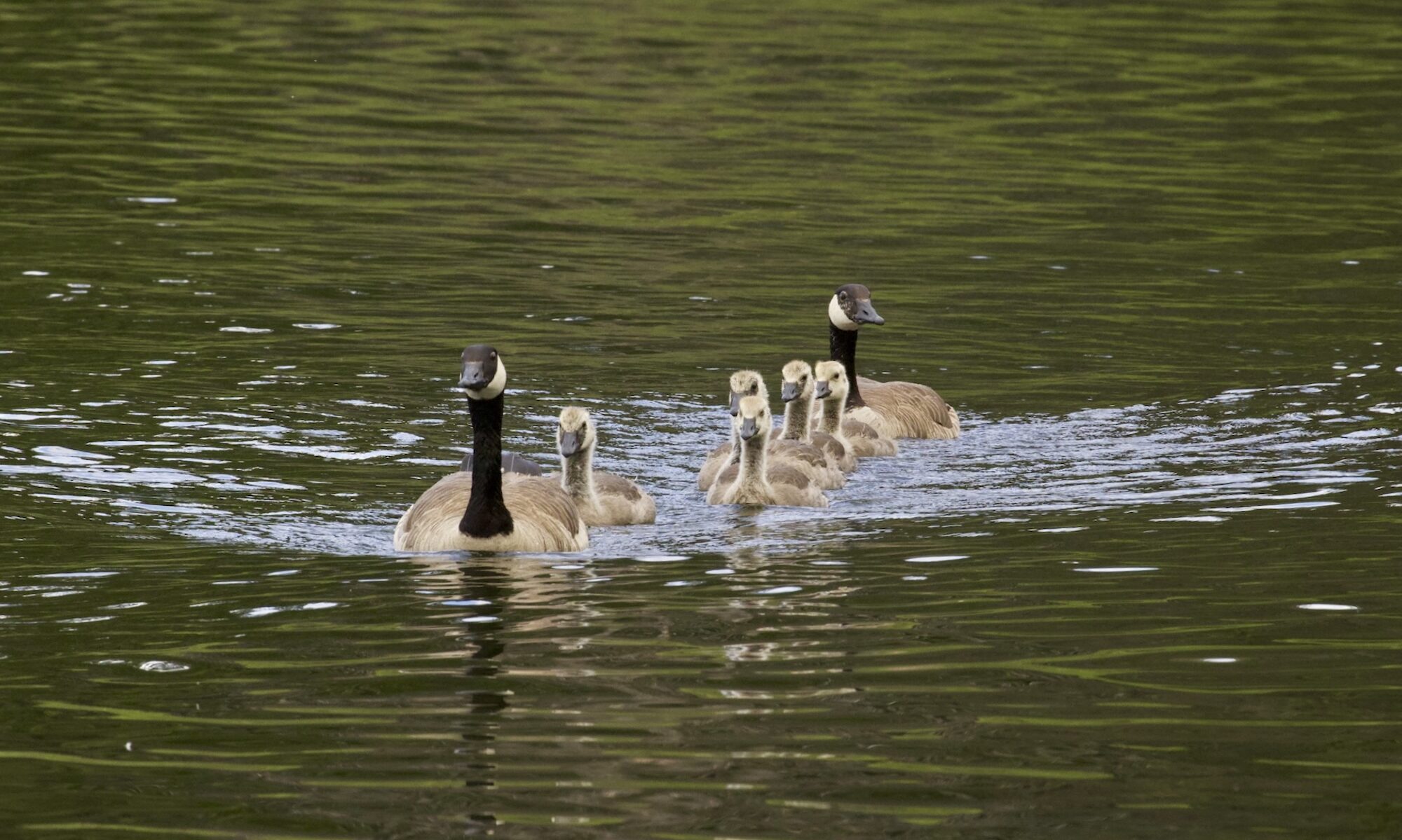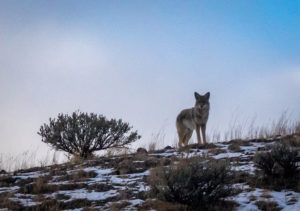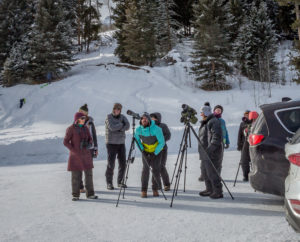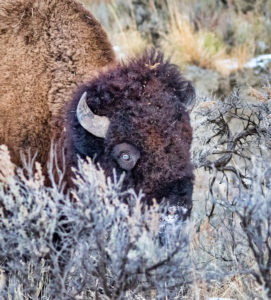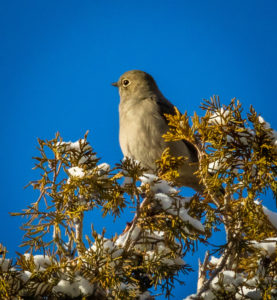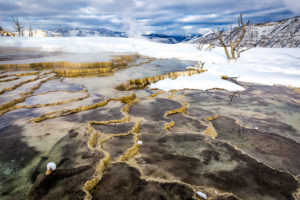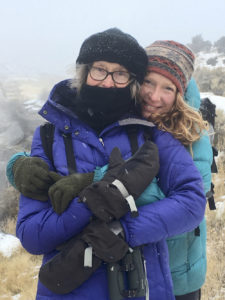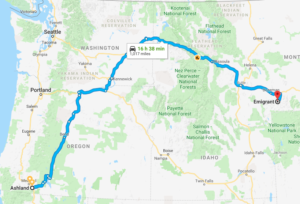
An easy 4-days drive found us in Emigrant, Montana, for the beginning of a week-long wintery adventure in Yellowstone National Park. Leaving Ashland in the early afternoon, our overnights were in Bend (where we swept up Alicia and Leo), a longish drive through the serene and pastoral Palouse to Spokane (Airport Ramada Inn LOVES dogs), a third night in Missoula at a cozy B’n’B on the Clark Fork River, and finally a final thrust through Bozeman to our substantial rental in the foothills near Chico Hot Springs. Aside from 30 miles of snow & ice outside of Coeur d’Alene, Idaho, driving conditions took a back seat to the entertaining podcasts downloaded each night to our phones. One particularly interested us: Rachel Maddow’s 7-part series titled “Bag Man” focusing on the 1973 political scandal surrounding Vice President Spiro Agnew and his resignation in the 1970s. And I though Nixon was a crook!
One of Alicia’s high school buddies is an environmental lawyer living in Missoula and we shared a VRBO with her family for a well-organized and festive gathering: Christmas stockings, shared meals, home-made wines from Healdsburg, crossword puzzles, and daily forays in and around the park in search of wildlife and excitement. 2 dogs assured us of that. On one particular day we saw all 3 species of “canids” residing in the park: a Coyote, Gray Wolf, and a Red Fox that inspired the title of this piece: A Three-Dog Day (four, if you count Leo and Gus). The fox treated me to a soaring leap into a snow bank in search of some hidden morsel.
Unlike driving through Yellowstone in the summer with an abundance of animals posing in fields of wildflowers, winter wildlife searches are different. Making things more challenging was the government “breakdown” that, as of this writing, is in its 22nd day. Unlike our 2 previous closure experiences (“illegally” birding the Cosumnes River Preserve in California, and peeing behind the locked outhouses along Ruby Road Scenic Drive near Arivaca, AZ), Yellowstone was relatively unaffected by political games being played by politicians. The road into and through the northern section of the the park remains open due to residences along the 57-mile 2-lane road. Visitors enter at Gardiner, MT, pass through Mammoth Hot Springs and head NE through Tower Junction and the Lamar Valley before leaving the park at Cooke City (and vice-versa). While never traveling the entire route, we explored the Lamar Valley twice and were graciously treated to remarkable viewing opportunities thanks to clear skies and the volunteers who position themselves (and their spotting scopes) at key observation points along the road. All of this is orchestrated by the park’s head wolf ranger who supplies volunteers with 2-way radios in order to share sightings. Mind you, Ranger Rick was himself “furloughed” but continued to perform his duty out of respect for his volunteers and unquestioned passion for his work.
I can’t imagine our visit without these dedicated citizen-scientists who not only kept the latrines stocked with TP (hence the affectionate nickname “TP Angels”) but kindly answered questions, many over and over again as one carload after another emptied its excited passengers at the sight of a spotting scope. We asked Kara, herself a visitor from Michigan (“Go Blue” was embroidered on her down parka) whether theses two-week volunteer shifts ever lost their allure. She sensibly answered, “No, we enjoy sharing our sightings and educating those unfamiliar with the park. And if ever we feel differently, well, we know how to pack up and move.” With the help of Kara and her colleagues, we saw our first gray wolf, an injured female camped out by a bison carcass nearly a mile from the road. Without a scope the animal was just another speck among many others in the expansive wilderness. Kara adjusted the height of her scope to accommodate viewers of all sizes and ages with patience, a smile, and then stepped back and protected herself from the frigid cold.
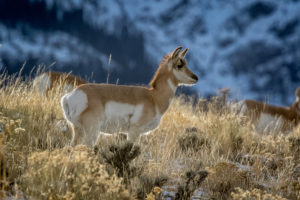
Bethany, a naturalist in her own right and suited perfectly for environmental legal challenges, absolutely amazed us with her ability to identify animals from the car; she routinely spotted critters that to us were merely tree stumps, shrubs and rocks. At one pull-out, there were several scopes trained on 6 white Mountain goats miles away and high on a ridge. Even through expensive optics those animals looked like grains of rice to me…until they moved about on their forage for food. (The spotters were originally scanning for a reported lioness and 2 cubs when they noticed the sheep.) Throughout the week we saw all 8 species of “ungulates” (hoofed herbivorous quadruped mammals): American bison, Bighorn sheep, Mountain goat, Pronghorn, Mule deer, White-tail deer, Moose and Elk. Furthermore, we learned that the Pronghorn’s closest living relatives are giraffes and okapi although they’re often (and incorrectly) referred to as the American antelope.
In addition to cruising the Lamar Valley with 3 pairs of ‘knockers scanning from both sides of the vehicle, we discovered additional magic walking in the sub-freezing weather. On day 2, after a wonderful morning of diving into Christmas stockings topped off with bottomless cups of coffee and fabulous French toast (the Bozeman Co-op’s bakery was worth waiting for), we bundled up for our initial journey into the park. Just before Mammoth Hot Springs (and not quite into Wyoming) is the Boiling River hot springs. Although locked out, the overflow lot adequately accommodated the group of mostly locals looking for a Xmas dip, and the icy ½ mile trail along the Gardner River made us appreciate our Yaktrax footwear. We spotted the first of many Dippers, and a pair of wading Canada Geese were foraging in the water for vegetation in the warmer water. Upstream, the literally boiling water created a steamy shroud that contrasted beautifully with the late-afternoon sunlight above the valley. The youngsters of our group wasted no time submerging into the man-made pools while we cowards meandered further along in the fresh snow. The scene was mesmerizing; low, warm sunlight glistened off rocks and stream-side vegetation, weighed down by hoar frost building in the freezing steam. A juvenile bald eagle did a fly-by over the bathers, and a blue-eyed Bison patiently swept its snout in the soft snow looking for grasses. After an hour soak, our intrepid youngsters quickly dressed and, not far from the trail, we spied a well-camouflaged baby elk baby elk nursing while its mama kept an attentive eye on us.
That’s not to say us oldsters didn’t get to enjoy the region’s geothermal waters. Not far from Emigrant is Chico Hot Springs Resort and Saloon and we enjoyed both. Tasty burgers, a great dance band, and clean water, filled daily, in huge neck-deep wading pools. Oh, and plenty of coping for that special beverage served in plastic cups from the sliding window to the bar. On our second visit, we allowed a little more time to hike the area beyond the resort. After passing a tree full of Mountain Chickadees, we happened onto a rustic cabin with “Townsend Ranch” emblazoned on the arch above the driveway. It was fun imagining that this was the biologist who first named the Townsend Solitaire that kept an eye on us throughout the week. Oh, yea, that and the Black-billed Magpie.
With all the game sightings in the Lamar Valley, we postponed visiting nearby Mammoth Hot Springs until our final day. Blue skies backdropped the multi-colored terraces comprising the nearly 50 hot springs that lie within the area. Boardwalks cover almost 2 miles around the Upper and Lower Terraces and cross-country ski trails provide access to even more for the more adventurous. The terraces are formed by water heated from a partially molten magma chamber deep underground. The hot, acidic solution dissolves large quantities of limestone on its way up to the hot springs on the surface. Above ground and exposed to the air, some of the carbon dioxide escapes from the solution causing the limestone to reform into a solid mineral. This white, chalky material is deposited as travertine that forms the waterfall-like terraces. Algae living in the warm pools have tinted the travertine into interesting shades of brown, orange, red, and green.
We cherish every opportunity to travel with Alicia, who is a very busy woman. Having a good friend and her family join us simply added to the fun. With superb wildlife spotting and opportunities for photography, we can only dream about our next visit—perhaps to Grand Teton National Park for different Wyoming perspective. During the past 2 weeks, we had plenty of sightings and experiences to process and enjoy, again and again.
Speaking of sightings, here’s a rough list: Mule deer, Pronghorn, Bighorn sheep, Mountain goat, Elk, Bison, Moose, Whitetail deer (the 8 ungulates present in the park), Kestrel, Bald and Golden Eagles, Merlin, Bohemian Waxwing, Cedar Waxwing, Black-billed Magpie, Mountain Chickadee, Townsend Solitaire, Rough-legged Hawk, Red-tailed Hawk, Belted Kingfisher, Mallard, Common Goldeneye, Canada Goose, Downy Woodpecker, Clark Nutcracker, American Robin, Otter, Gray Wolf, Coyote, Red Fox
